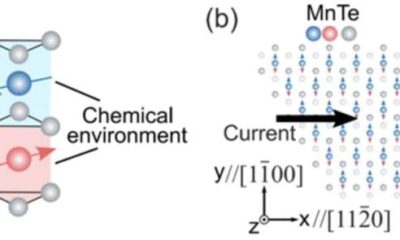Science
Scientists Achieve Soliton Microcombs in Lithium Niobate Chips

Recent advancements in integrated photonics have led to a significant breakthrough in the development of soliton microcombs using X-cut thin-film lithium niobate (TFLN) microresonators. A team of researchers, spearheaded by Professor Fang Bo from Nankai University and Professor Qi-Fan Yang from Peking University, has successfully demonstrated the formation of these microcombs, which are essential for various optical applications including optical frequency synthesis and advanced computational tasks.
The innovative approach allows for the co-integration of high-speed modulators and efficient frequency doublers on TFLN chips. This configuration, however, faced challenges due to a strong Raman response that previously hindered soliton formation. By precisely aligning the racetrack microresonator with the optical axis, the team managed to mitigate the Raman nonlinearity, enabling soliton formation under continuous-wave laser pumping. The results of their study were published in the journal eLight.
Breakthrough in Microcomb Technology
The researchers observed that the soliton microcomb spectra could be extended to 350 nm when utilizing pulsed laser pumping. This achievement broadens the capabilities of TFLN photonics and facilitates the potential for the integration of fast-tunable, self-referenced microcombs. Such advancements are set to revolutionize applications in optical communication, computation, timing, and spectroscopy.
To characterize the polarization-dependence of the Raman response, the research group employed Raman spectroscopy. They noted that the Raman intensities decreased as the pump polarization shifted from parallel to perpendicular concerning the optical axis. Two racetrack microresonators were tested with different orientations on TFLN-on-insulator chips. In the first device, where the straight waveguides were perpendicular to the optical axis, a stronger overall Raman response was noted. Conversely, the second device, with waveguides parallel to the optical axis, exhibited a weaker response, allowing for the successful generation of soliton microcombs.
The experimental findings reveal significant details about the soliton microcombs. The electrical spectrum and single-sideband phase noise of the soliton repetition frequency were documented, indicating stability and reliability in performance. Furthermore, soliton microcombs can also be generated using synchronized pulsed lasers, which enhance optical-to-optical conversion efficiencies and expand the spectral range.
Implications for Future Technology
The demonstration of soliton microcombs on X-cut TFLN opens new avenues for fully integrated on-chip comb functionality. Unlike silicon nitride microcombs, the TFLN platform allows for monolithic integration with electrodes, providing greater flexibility for controlling both the repetition frequency and the carrier-envelope offset frequency of soliton microcombs. This integration is crucial for developing chip-based optical clocks and aligns with recent advancements in visible laser technologies and photonic-integrated atomic systems.
The research received financial backing from the Beijing Natural Science Foundation and the National Natural Science Foundation of China, among others. The collaborative effort highlights the global push towards leveraging advanced materials in photonics, underscoring the potential for transformative applications in technology and science.
This pioneering work not only expands the functional capabilities of TFLN photonics but also lays the groundwork for future innovations in optical systems, marking a significant step forward in the field of integrated photonics.
-

 Lifestyle2 weeks ago
Lifestyle2 weeks agoBelton Family Reunites After Daughter Survives Hill Country Floods
-

 Education2 weeks ago
Education2 weeks agoWinter Park School’s Grade Drops to C, Parents Express Concerns
-

 Technology2 weeks ago
Technology2 weeks agoByteDance Ventures into Mixed Reality with New Headset Development
-

 Technology2 weeks ago
Technology2 weeks agoMeta Initiates $60B AI Data Center Expansion, Starting in Ohio
-

 Lifestyle2 weeks ago
Lifestyle2 weeks agoNew Restaurants Transform Minneapolis Dining Scene with Music and Flavor
-

 Technology7 days ago
Technology7 days agoMathieu van der Poel Withdraws from Tour de France Due to Pneumonia
-

 Technology2 weeks ago
Technology2 weeks agoGlobal Market for Air Quality Technologies to Hit $419 Billion by 2033
-

 Health2 weeks ago
Health2 weeks agoSudden Vision Loss: Warning Signs of Stroke and Dietary Solutions
-

 Technology2 weeks ago
Technology2 weeks agoRecovering a Suspended TikTok Account: A Step-by-Step Guide
-

 Technology2 weeks ago
Technology2 weeks agoAnalysts Highlight Top 5 Altcoin Presales Ahead of Market Surge
-

 Technology2 weeks ago
Technology2 weeks agoTrump Faces Internal Struggles Over Epstein Files Handling
-

 Technology2 weeks ago
Technology2 weeks agoUK Initiates Relocation Scheme for Afghans After Data Breach











